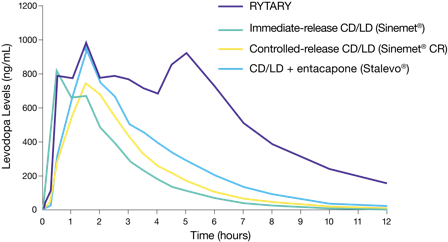RYTARY contains the same medication as IR CD/LD, but it’s formulated differently






Adapted from Hsu et al, 2015.
Predicted steady-state profile based on RYTARY dosed every 6 hours and IR CD/LD dosed every 3 hours.
The multi-dose curves of levodopa plasma concentration levels were developed based on superposition of observed data from healthy volunteers receiving single doses.
CD/LD medications are a mainstay of Parkinson’s treatment, with IR CD/LD being among the most commonly prescribed. However, the fact that it’s immediate release means that, while it works quickly, each dose lasts for shorter periods of time as Parkinson’s progresses. So once people have been taking it for a while, they begin to fluctuate between “On” and “Off” periods.
RYTARY delivers each dose of medication quickly, and then sustains LD levels over a longer period of time, leaving you with less “Off” time and more “On” time throughout the day.
RYTARY provides an extended delivery of medication vs other CD/LD treatments
RYTARY is uniquely formulated to be both immediate and extended release

- 1/3 of the CD/LD beads are immediate release, which allows RYTARY to start working quickly
- 2/3 of the CD/LD beads are extended release, which, when combined with the other beads, allows RYTARY to work up to 4 to 5 hours
Together, this may reduce the amount of “Off” time you experience each day.
